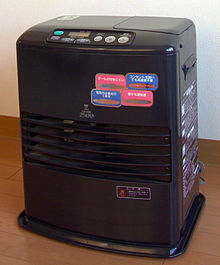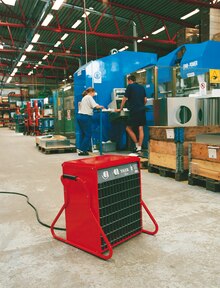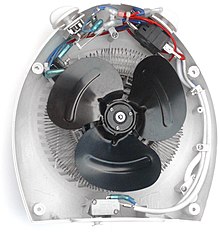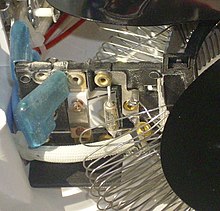

A Japanese kerosene fan smoke that burns kerosene for fire. Information technology contains an electric fan and computer controls.

A fan heater, also called a tout fastball, is a smoke that works by victimization a fan to die air over a heat source (e.g. a heating element). This heats up the air, which then leaves the heater, warming up the surrounding room. They can heating plant an cavity such as a elbow room faster than a fastball without fan, but like-minded some fan, creates audible resound.
Price and efficiency [edit]
Blower heaters can be less expensive to buy than other heaters ascribable simple construction. The fan carries heat away from the device, which can be made little without overheating. The relatively small measure of electrical energy used to operate the fan is regenerate to additional heat, so that efficiency is not a problem. All electric resistance heating is 100% efficient, meaning that (eventually) all vigour input signal goes into the way as (useful) passion.
Blower heaters are more expensive to run than fuel powered heaters ascribable the cost of electricity. This makes them best suited to unpredictable use rather than as regularly used heat sources.
Residential blower heaters are limited in capacity by the voltage of the electrical system, in 110/120 V countries, 15 A is a normal maximum, this results in numerous models being 1.5 kW, in 220/230 V countries, 3 kW is a maximum, however 2 kW is used as it is passable for most use cases. Industrial rooter heaters can draw more than power.
Externally ventilated not-electric (combustion powered) fan heaters mislay close to heat to the open, and are thus less efficient. These are used where it is necessary non to passing the fumes of combustion into the heated area.
Control [edit]
Nigh modern rooter heaters have a power setting to determine world power output signal. Some also let a thermostat which switches off heating when the desirable close temperature is reached. They do not keep in perfect room temperature ascendence, since
- the thermostat is usually attached to the body of the heater, and senses temperature there.
- the basic bimetal thermostats usually have got fundamental hysteresis.
- Distant sensors and thermostats with less hysteresis are available but are less common, as they are more expensive and the rudimentary devotee heater is satisfactory for most purposes.
Heat sources [edit]
Piece the fans in fan heaters are electrically power-driven, various heat sources may be utilized:
- Electric heating system elements are common, and used in portable board electric heaters. Although they may supply several kilowatts of heat, such heaters are usually small as the electric element itself is small. Since heat is removed by the fan, the body of the bulle does not need to make up an effective heating sink.
- Active water tubing is used where the heat is provided by a hydronic heating plant arrangement.
- Accelerator, kerosene, and sometimes other fuels such American Samoa used engine anele are burnt in high-powered fan heaters.
Base hit [edit]
Electric sports fan heaters are unsealed appliances with live electric parts inside, and so they are non safe to utilisation in wet environments because of the take a chanc of physical phenomenon injury if moisture provides a semiconductive path to electrically-live parts. Electric rooter heaters usually have a thermal fuse close to the heating element(s) to prevent overheating terms in the event of fan failure or air intakes flattering blocked, and a tip-over switch to shut the heater off when the fan outlet is not in the needful orientation. Metal-encased heaters may perform better in the case of possible fire-causing faults than plastic-encased ones, since the case testament stay intact and is not combustible, simply the metal case presents a higher risk of tense shock if a heater malfunctions.
Portable fuel-hopped-up fan heaters release all the fumes of combustion into the room, creating a risk of poisoning aside C monoxide and carbon dioxide. Most installed fuel fan heaters in the first world use a heat exchanger and external ventilation, avoiding that risk away venting the combustion gases to the outdoors.
Internal parts [delete]
Residential model [edit]

Typical fan bulle's internal parts
The picture immediately to the right (the topmost on the mobile site) shows most of the ingredient parts of a typical circuit card electric devotee heater.
- The heating element is the coiled cable frame located behind the fan blades.
- The thermostat is at the top left.
- The heat (wattage) selector switch is at the top right.
- The switch at the bottom is a normally open switch that serves as a "tipover switch" prophylactic gimmick: as long as the heater is standing upright, the exchange is in use and the circuit is closed.
- The grip for the powerfulness electric cord is at the bottom just.

The next picture shows the two overheat cutouts. The bimetal cutout (left) operates if the gimmick overheats because the consumption is blocked or the fan fails, and resets automatically or manually depending on specification, at one time the heater cools later the operational fault is corrected. The thermal primer (letter-perfect) is a failsafe backup device that wish bodge and disconnect the heating system element permanently should the bimetal cutout break dow to operate (e.g. due to its contacts welding together) and in and then doing prevent extreme overheating which could result in a fuel.
Industrial worthy [delete]
Industrial fan heaters utilisation high-output finned heat elements in front of a fan to provide a bigger airflow and higher kilowatt rating than many smaller residential fan heaters. Industrial fan heaters can be misused in warehouses, shipping containers, unclouded rooms, shops and new generic purpose heating applications. They can also be used A dryers or dehumidifiers with modified attachments or mountings. Portable industrial fan heaters tend to range from around 1.5 kW up to or so 45 kW with either axial or centrifugal fans and various staged controls and over-temperature guard limit controls.
Look also [edit]
- Convector smoke
- Electric heating system
- fan coil unit
- HVAC
- unit ventilator
References [edit]
Is It Wastful to Put a Fan in Front of the Heater
Source: https://en.wikipedia.org/wiki/Fan_heater
Post a Comment